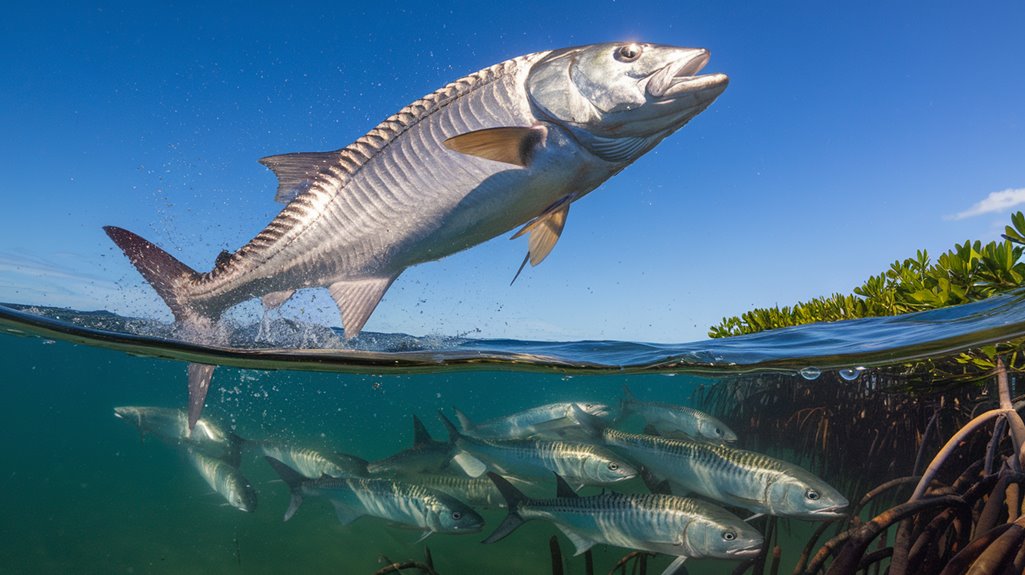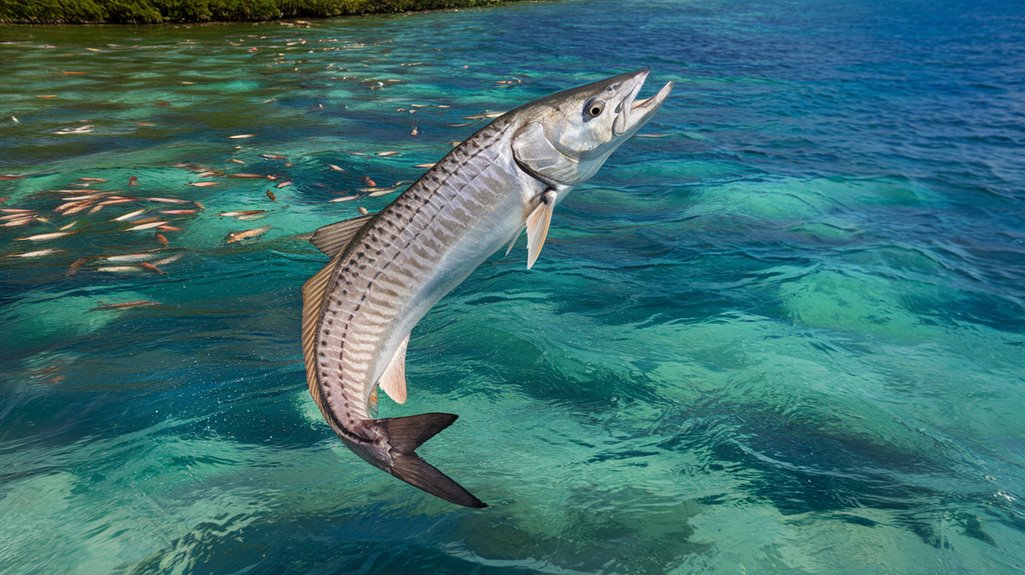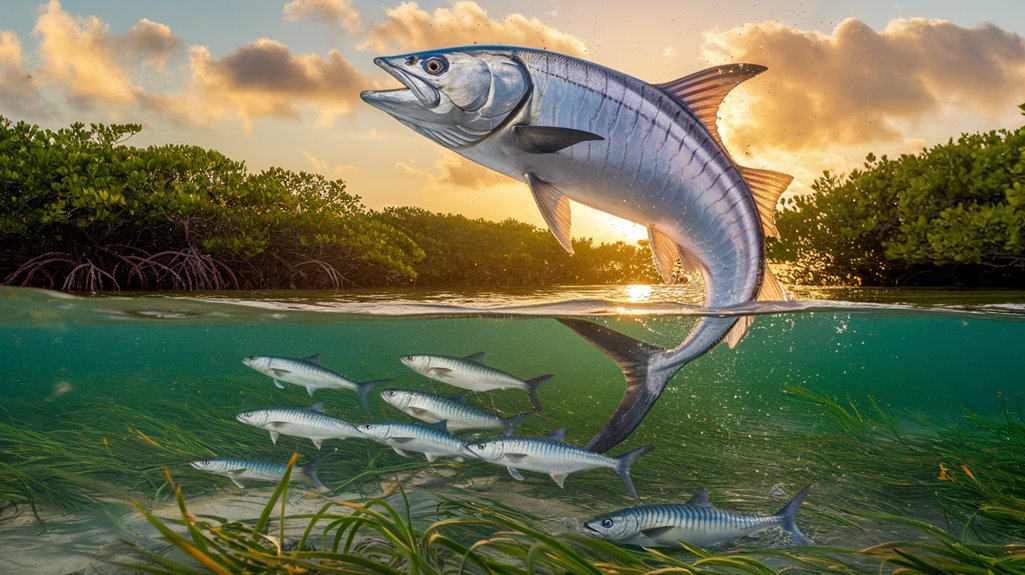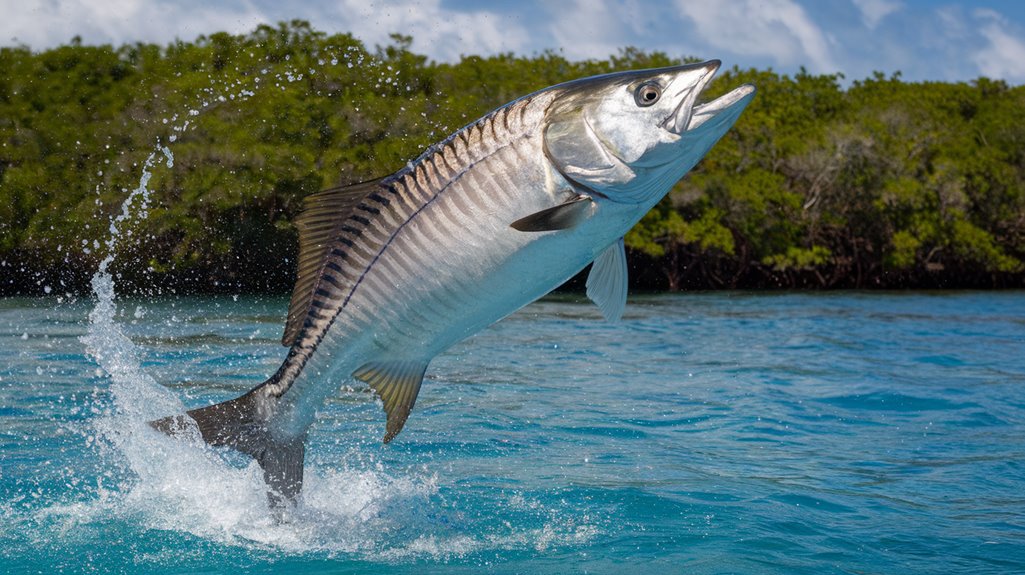You'll find tarpon (Megalops atlanticus) to be among the most remarkable marine specimens, with adult females reaching up to 8 feet in length and weighing 280 pounds. Their habitat range spans from 45°N to 30°S latitude, encompassing both coastal estuaries and pelagic zones. While these measurements represent typical specimens, environmental variables and regional distinctions create notable size variations that warrant closer examination through multiple biological and ecological factors.
Key Takeaways
- Tarpon reach lengths of 4-8 feet at maturity, with females growing larger than males and weighing up to 300 pounds.
- Tarpon inhabit tropical and subtropical waters from Virginia to Brazil, including the Gulf of Mexico and Caribbean Sea.
- They thrive in diverse environments from shallow estuaries to offshore waters due to their specialized air-breathing swim bladders.
- Juvenile tarpon prefer protected backbay habitats, while adults frequent coastal waters and estuaries for feeding.
- Water quality, temperature, and prey availability directly influence tarpon size development and distribution patterns.
Physical Dimensions and Growth Patterns

While tarpon exhibit remarkable size variation across their life stages, these magnificent fish typically reach lengths between 4 and 8 feet at maturity. The maximum recorded length approaches 8 feet, with adult tarpon weights fluctuating between 60 and 280 pounds in coastal waters. You'll find that female tarpon demonstrate sexual dimorphism, growing substantially larger than males, with some specimens exceeding 300 pounds compared to the males' typical 80-100 pound range.
The growth rate of juvenile stage tarpon is particularly notable, as their metabolic efficiency enables rapid size increases in suitable habitats. This impressive development continues throughout their extensive lifespan, which can exceed five decades, with documented cases of individuals reaching 63 years in controlled environments.
Natural Habitat Distribution
Throughout their extensive geographic range, Megalops atlanticus and M. cyprinoides inhabit diverse aquatic ecosystems spanning tropical and subtropical waters. You'll find M. atlanticus distributed from Virginia's coastal waters south to Brazil, including the Gulf of Mexico and Caribbean regions. These tarpon demonstrate remarkable adaptability, occupying multiple habitat types from shallow estuarine environments to offshore marine waters.
The species' physiological adaptations, particularly their specialized swim bladders, enable them to thrive in brackish water environments with fluctuating conditions. This unique respiratory capability allows tarpon to penetrate upstream into freshwater systems and survive in oxygen-depleted waters. Their habitat distribution extends from coral reef systems to coastal mangroves, while M. cyprinoides occupies similar niches across the Indo-Pacific region, from eastern Africa through Southeast Asia.
Environmental Factors Affecting Size

Several key environmental factors greatly influence tarpon size development, with water quality parameters and prey availability serving as primary determinants. You'll find that habitat conditions directly impact metabolic rates through variations in water temperature, salinity, and dissolved oxygen levels. Juvenile tarpon particularly depend on nutrient-rich coastal waters and estuaries, where abundant food sources like shrimp, mullet, and crabs support optimal growth patterns.
What's remarkable is tarpon's ability to gulp air, enabling them to thrive in low-oxygen environments where other species cannot. This adaptive feature allows them to access diverse habitats and maintain growth rates even in challenging conditions. Research demonstrates that specimens reaching maximum size potential are consistently found in environments combining favorable water parameters with plentiful prey availability, underscoring the critical relationship between environmental factors and tarpon development.
Feeding Grounds and Size Correlation
The correlation between tarpon feeding grounds and maximum size potential emerges from distinct habitat preferences across their life stages. You'll find adult tarpon inhabiting shallow coastal waters and estuarine environments, where they access abundant feeding grounds containing mid-water bait fish, shrimp, and crabs. This nutrient-rich diet directly influences their growth trajectory, enabling them to reach lengths of 4-8 feet and weights up to 280 pounds.
Juvenile tarpon select protected backbay habitats with reduced predator density, optimizing their early growth phases. The availability of food in these environments is vital, as tarpon's unique ability to utilize atmospheric oxygen allows them to exploit diverse feeding grounds, even in low-oxygen conditions. This physiological adaptation maximizes their access to various food sources, supporting sustained growth throughout their development.
Migration Patterns and Regional Size Variations

When tarpon undertake their seasonal migrations along the Gulf Stream currents between the Florida Keys and Costa Rica, you'll observe distinct size variations correlated with their geographical distribution. You'll find juvenile tarpon primarily in coastal estuaries, where they develop before joining adult tarpon in offshore waters. The Florida Keys specimens typically measure 4-8 feet and weigh 60-280 pounds, with regional size variations influenced by local environmental conditions and prey availability.
During spawning migrations in late spring to summer, you'll notice larger specimens congregating in specific areas, their movements synchronized with lunar cycles. These migration patterns create a dynamic size distribution, where you'll encounter larger tarpon in regions offering ideal habitat conditions and abundant food sources, directly impacting their growth rates and maximum size potential.
Frequently Asked Questions
How Old Is a 100LB Tarpon?
You'll find that a 100-pound Megalops atlanticus specimen typically reaches this mass at 4-5 years of age, during their rapid juvenile growth phase before sexual maturity.
What Is Considered a Big Tarpon?
You'll typically classify a big tarpon as exceeding 100 pounds, with specimens reaching 150-200 pounds considered trophy-class. Adult females can attain exceptional sizes, surpassing 250 pounds in ideal conditions.
How Long Is a 200 Lb Tarpon?
You'll find that a 200-pound tarpon (Megalops atlanticus) typically measures 6-7 feet in total length, with its elongated fusiform body displaying characteristic silver-plated cycloid scales.
What Is the Average Size of a Florida Tarpon?
You'll find Florida tarpons typically measure 4-6 feet in length and weigh 80-100 pounds, though specimens can reach greater dimensions. Adult females regularly exceed these morphometric parameters.
Conclusion
You'll find that Megalops atlanticus exhibits remarkable morphometric variability, with specimens reaching 2.4m in length and 127kg in mass. Their distribution spans 38°N to 40°S latitude, where they're mainly found in waters ranging from 20-30°C. The species' size correlates strongly with habitat quality, dissolved oxygen levels (>4mg/L), and prey density in their estuarine-marine changeover zones. Your understanding of their migratory patterns must account for seasonal bathymetric movements.

